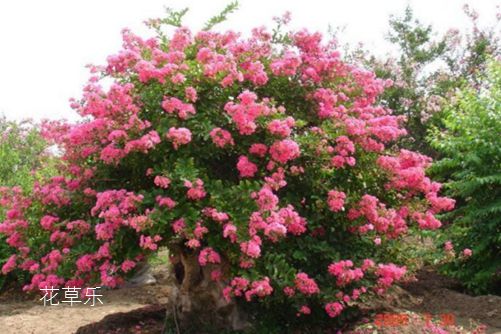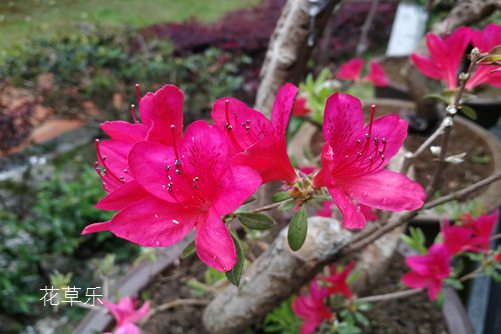It is said that finch plum is easy to live and difficult to raise. In fact, watering is the key to the maintenance of finch plum bonsai.
Mei tree posture old Qiu Jin, known as bonsai "seven sages" one of the laudatory name, for Lingnan bonsai in one of the five famous trees. White flowers bloom, and the fruit ripens to eat. Sparrow plum likes light, bears shade, likes warm and humid climate, bears pruning. It is one of the main tree species of Chinese potted landscape. How can we maintain a good pot of cherry bonsai? The following flower music Xiaobian shares with you the selection of piles for potted birds and the introduction of maintenance methods for potted birds.
It is said that finch plum is easy to live and difficult to raise. In fact, watering is the key to the maintenance of finch plum bonsai.

1. Select stumps
Most of them grow on the mountain slopes. Pile digging time is generally best in late autumn and spring. Pile digging in late autumn should pay attention to windproof measures after excavation. It is recommended to hit mud at the root and immediately enter the basin. The basin mound is high. Winter digging, must pay attention to cold frostbite, unearthed, the application of packaging bags and other things will be packaged to avoid frostbite roots.
II. Introduction to the maintenance method of sparrow plum
1, cultivation: planting soil should use plain soil, such as river sand, idyllic soil mainly, need drainage ventilation, moisture, sterile. After planting, water should be poured once and moved to the leeward of weak light for maintenance. Water should be sprayed once a day in the morning and evening to keep the branches moist to facilitate the survival of plant cells. After the new roots sprout, they can enter normal management.
2. Water control: The key to the survival of newly planted finches is watering. Plum birds like wet, afraid of drought and flood. Pot soil can neither be too dry, nor can it accumulate water. Generally, watering can be divided into:
1) according to the season watering, winter should be less watering, spring recovery should be moisturizing, summer high temperature water, autumn cold see water marks.
2) watering according to the growth condition, the pile blank should be kept moist at the beginning of planting, the germination should be watered thoroughly, the growth should be watered more, and the growth should be watered less.
3) Combine watering with weather, irrigate more in sunny days, irrigate less in cloudy days, and master watering according to dry and wet conditions of basin soil in cloudy days.
4) Water according to the environment, more water upstairs, less water downstairs, more water in the open place, less water in the garden.
3, scientific fertilization: finches do not apply in winter, less in summer, spring and autumn, early planting weak piles do not apply. The principle of frequent application of strong piles, re-application before pruning and no application after pruning.
4. Pruning and maintenance: In principle, after germination and survival, finch plum shall not be pruned in the same year, and shall be allowed to grow wildly to promote the development and health of root system. If it grows too vigorously, it can be appropriately thinned according to the shape, strengthen light ventilation, concentrate nutrients, and thicken the modeling branches. In the modeling stage, according to the layout of the branch selection, but to consider the vascular bundle one-way conduction problem, so the old column pot age is longer, the modeling branch should be reserved next to one, so as to promote the water line cell activity, but also for preparation. The change of pots is general, 4~5 years for large pots, 2~3 years for medium pots and 1 year for small pots. This can keep the root system vigorous, regenerate new roots, effectively avoid rabbit branch retraction, and keep the whole tree vigorous.
III. Key Tips for Sparrow Plum Conservation
The vascular bundle is unidirectional conduction, but a damaged branch will cause the phenomenon of partial branches, damaged will die, no damaged branch can not heal the damaged vascular bundle. Therefore, maintenance should pay attention to a branch damaged, basically this branch is not saved.
IV. Bonsai Common Sense Sharing
1. Bonsai Qixian: refers to Huangshan pine, Zuan Luo Bai, elm, maple, holly, ginkgo, finch plum, each with its own characteristics of seven species.
2, bonsai four families: refers to the golden finch, boxwood, Yingchun, velvet needle cypress, four more harmonious and poetic tree species.
3. Eighteen scholars refer to plum, peach, tiger thorn, Jiqing, wolfberry, azalea, cypress, papaya, Chinese plum, South Tianzhu, Camellia, Podocarpus pine, Xifu begonia, Phoenix tail bamboo, Lagerstroemia, pomegranate, June snow, mast flower, etc. There are 18 species with various shapes and styles.
reviewed
Time: 2019-04-23 Click:
- Prev

How can crape myrtle blossom for a hundred days? It can be done by using the method of round pruning.
The common name of crape myrtle is Baizhihong, with beautiful trees, gorgeous flowers and colors, and can bloom for more than a hundred days. In order to make potted crape myrtle have many flowers, colorful flowers and bloom many times, in addition to selecting dwarfing varieties, what other maintenance and management measures can make crape myrtle increase the number of blossoms, prolong the flowering time, and improve the effect of flower appreciation?
- Next

How to raise azaleas? the focus of rhododendron culture is to manage well before and after flowering.
Azalea alias Yingshanhong, Corolla such as funnel-shaped, there are red, yellow, apricot red, white. It is one of the top ten traditional famous flowers in China, and it is a kind of woody flowers that mainly watch flowers. How do azaleas grow brightly colored flowers? in addition to strengthening daily routine management, what should be paid attention to in rhododendron culture?
Related
- Fuxing push coffee new agricultural production and marketing class: lack of small-scale processing plants
- Jujube rice field leisure farm deep ploughing Yilan for five years to create a space for organic food and play
- Nongyu Farm-A trial of organic papaya for brave women with advanced technology
- Four points for attention in the prevention and control of diseases and insect pests of edible fungi
- How to add nutrient solution to Edible Fungi
- Is there any good way to control edible fungus mites?
- Open Inoculation Technology of Edible Fungi
- Is there any clever way to use fertilizer for edible fungus in winter?
- What agents are used to kill the pathogens of edible fungi in the mushroom shed?
- Rapid drying of Edible Fungi

